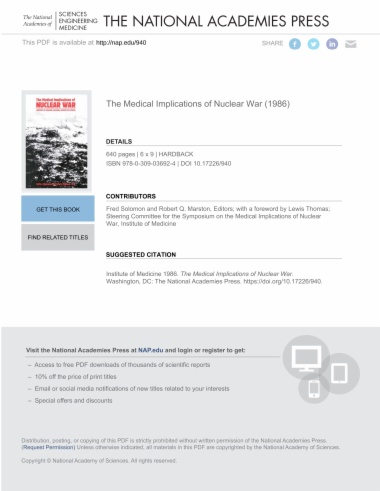Written by world-renowned scientists, this volume portrays the possible direct and indirect devastation of human health from a nuclear attack. The most comprehensive work yet produced on this subject, The Medical Implications of Nuclear War includes an overview of the potential environmental and physical effects of nuclear bombardment, describes the problems of choosing who among the injured would get the scarce medical care available, addresses the nuclear arms race from a psychosocial perspective, and reviews the medical needs—in contrast to the medical resources likely to be available—after a nuclear attack. "It should serve as the definitive statement on the consequences of nuclear war." —Arms Control Today
- Cover
- Front Matter
- Understanding and Preventing Nuclear War: The Expanding Role of the Scientific Community
- Part I: Nuclear War with Modern Weapons: Physical Effects and Environmental Consequences
- 1 Possible Fatalities from Superfires Following Nuclear Attacks in or near Urban Areas
- 2 A Review of the Physics of Large Urban Fires
- 3 Recent Assessments of the Environmental Consequences of Nuclear War
- 4 Nuclear Famine: The Indirect Effects of Nuclear War
- 5 Nuclear Winter: The State of the Science
- 6 Atmospheric Perturbations of Large-Scale Nuclear War
- 7 Possible Toxic Environments Following a Nuclear War
- 8 Radioactive Fallout
- Part II: Health Consequences of Nuclear War
- 9 Casualties Due to the Blast, Heat, and Radioactive Fallout from Various Hypothetical Nuclear Attacks on the United States
- 10 Acute Radiation Mortality in a Nuclear War
- 11 Burn and Blast Casualties: Triage in Nuclear War
- 12 Food and Nutrition in the Aftermath of Nuclear War
- 13 Psychological Consequences of Disaster: Analogies for the Nuclear Case
- 14 The Immunological Impact of Nuclear Warfare
- 15 Expected Incidence of Cancer Following Nuclear War
- 16 Genetic Consequences of Nuclear War
- Part III: Medical Resource Needs and Availability Following Nuclear War
- 17 Medical Supply and Demand in a Post-Nuclear-War World
- 18 The Consequences of Nuclear War: An Economic and Social Perspective
- Part IV: Images and Risks of Nuclear War: Psychosocial Perspectives
- 19 Children's and Adolescents' Perceptions of the Threat of Nuclear War: Implications of Recent Studies
- 20 Scandinavian Youth View the Future: A Preliminary Report of a Large Questionnaire Survey
- 21 Adult Beliefs, Feelings, and Actions Regarding Nuclear War: Evidence from Surveys and Experiments
- 22 Hope and the Denial of Stress in the Nuclear Age
- 23 The Nuclear Arms Race and the Psychology of Power
- 24 Managerial Demands of Modern Weapons Systems
- 25 Sources of Human Instability in the Handling of Nuclear Weapons
- 26 The Impact of Crisis-Induced Stress on Decision Making
- Part V: Long-Term Consequences of and Prospects for Recovery from Nuclear War: Two Views
- 27 View I
- 28 View II
- Concluding Remarks
- Summary and Perspective: With Some Observations on Informed Consent
- Glossary
- Biographies of Contributors
- Index

